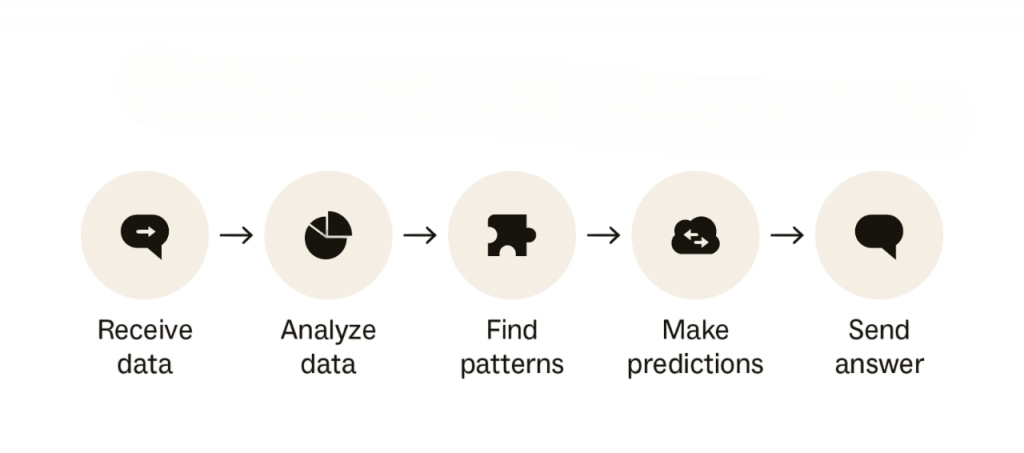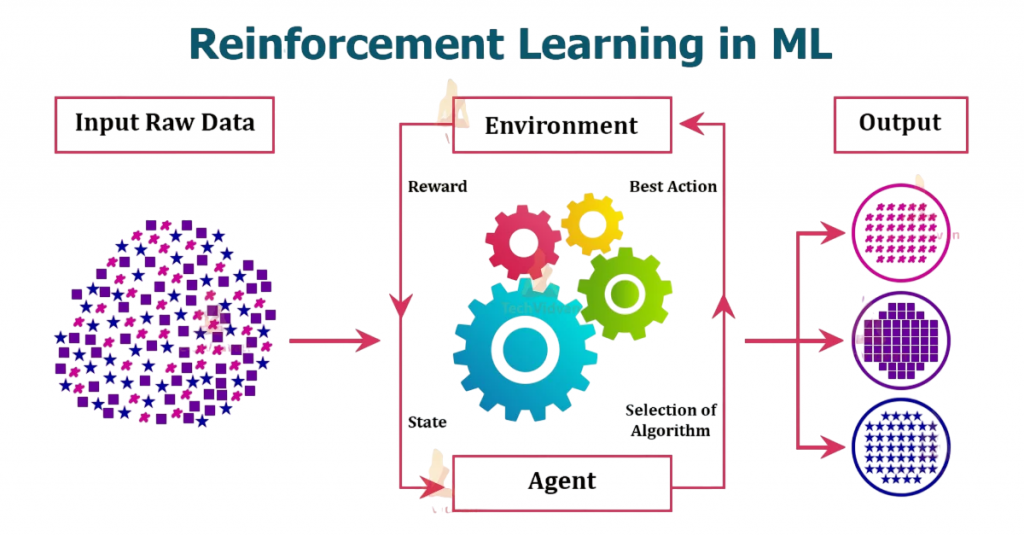
- Introduction to Machine Learning.
- Why is machine learning such a hot technology?
- What machine learning is and why it’s so effective.
- There are 3 kinds of machine learning.
- What is supervised and unsupervised?
- What is reinforcement learning?
- Differences between supervised and unsupervised Learning.
- Applications of Machine Learning
- Conclusion
Introduction to Machine Learning
The goal of the field of machine learning algorithms is to make it possible for computers to learn from data without explicit programming. It entails creating algorithms that, with increased data exposure, can perform better over time. Much like humans learn and get better through experience, machine learning (ML) essentially assists computers in making predictions or decisions based on the patterns they discover in data. A branch of computer science and artificial intelligence (AI) known as machine learning (ML) attempts to equip computers and other machines with the capacity to replicate human learning and perform tasks autonomously Machine Learning Training. Python and R are the two most frequently used languages in machine learning. and become progressively better at them with additional information and time. A type of artificial intelligence that learns to analyze data without explicit direction is machine learning. Machine learning technology can be used to process large quantities of historical data, as well as detect patterns and predict new relationships between data that were previously unknown.
Why is machine learning such a hot technology?
Machine learning is a subfield that deals with educating machines on the best means of tackling unseen issues. Arthur Samuel, a computer scientist, coined the term “machine learning” for the first time in 1959. Machine learning has developed rapidly since then. The past several decades have witnessed the efficiency of machine learning models. Artificial learning algorithms have been Bagging vs Boosting in Machine Learning employed to deal with various difficult problems. Forecasting stock exchange trends is one of them. To most of us, the graphs of stock exchanges seem more random; we are even unable to predict how they will act.

But a group of computer scientists and mathematicians decided to use machine techniques to solve this problem. Computer science graduate David Siegel, math graduate John Overdeck, and I all won silver medals at the International Math Olympiad. They formed a hedge fund firm named Two Sigma. Two Sigma creates trading strategies through big data analysis, machine learning, and artificial intelligence. Python and R are commonly used languages. Other languages like Java, C++, and JavaScript also have a role in specific areas of machine learning. Two Sigma proved to be one of the best firms in the world. John and David are now both billionaires. Among many other fields, machine learning finds use in mathematics, gaming, and economics.
Ready to Get Certified in Machine Learning? Explore the Program Now Machine Learning Online Training Offered By ACTE Right Now!
What machine learning is and why it’s so effective.
- Let’s understand machine learning models by taking an example. Imagine a system that predicts asthma attacks.
- This system can use satellite data to know pollution levels, environmental conditions, places, etc.
- These models can further study the relationship between asthma attacks and their factors.
- This relationship between knowledge and real-time data can be used to predict the time and place where a user may have an asthma attack What Is Machine Learning .
- Python and R are two common languages. Let’s use an example to better understand machine learning models. Consider a system that can anticipate asthma episodes.
- This system may use satellite data to determine locations, environmental conditions, pollution levels, and more.
- The association between asthma attacks and their contributing factors can be further investigated using these models.
- The time and location of a user’s potential asthma attack can be predicted using this relationship information and real-time data.
There are 3 kinds of machine learning
- Supervised learning models are trained on datasets that have been previously labeled and collected. Models then try to make conclusions from these datasets. We call these datasets training datasets. The model that has been learned is then utilized to predict a value based on unknown datasets. Let’s consider an example of a supervised group learning-based machine model that will be able to recognize cat photos among numerous images.
- Supervised learning has the drawback of having a very narrow scope. For the most part, manually labeling thousands of cat photos is an extremely difficult task. What if we wanted to build a model that could tell the difference between birds and animals? It would not fall under the purview of supervised learning. Unsupervised learning is utilized for these kinds of issues. Unsupervised learning models attempt to cluster or group the data, as opposed to supervised learning models Decision Trees in Machine Learning, which aim to predict a value. It looks for similarities between different data points. The clustering procedure is guided by feature vectors. The potential group in which the value might occur is then predicted using this cluster of data. In supervised learning, the neural networks try to forecast a value, while in unsupervised learning, they try to forecast a group. This is the main difference between supervised and unsupervised learning.
- The major disadvantages of supervised and unsupervised learning are that they are based on datasets. It is not possible now to have a dataset for all problems. Where datasets are not available, the model has to create its own dataset for itself to learn. The most prevalent use of reinforcement learning is in gaming bots. For example, it is impossible to feed a dataset for all the possible chess games played. By engaging in a game of chess with itself and determining the best moves, reinforced learning solves this problem. Policy networks are employed in reinforcement learning. It seeks outstanding moves Best Deep Learning Books to Read . The policy gradient is the probability that an action will lead to a valid output move. Reinforcement learning is mainly used in game-playing agents’ neural networks. A very good example of the reinforcement learning model in data analytics is the famous game between AlphaGo and Lee. In this case, it was not possible to create a dataset of moves that could beat Lee.
- Supervised: Machine learning models are trained on labeled SQL data sets, which allow the algorithm to learn and become more accurate over a period of time. For example, an algorithm would be trained with images labeled by humans as dogs and other items, and the machine would learn automatically how to identify images of dogs. Supervised machine learning is the most commonly used type nowadays Machine Learning Training.
- Unsupervised: A program scans unlabeled data for trends in unsupervised machine learning. Unsupervised machine learning is the capacity to find trends or patterns that humans are not looking for. An unsupervised machine learning software, for example, might scan web sales SQL data and separate different customer groups.
- Agent: The entity that makes decisions and interacts with the environment.
- Environment: The external world the agent interacts with, providing it with observations and rewards.
- Action: The decision made by the agent in a given situation.
- Reward: The feedback received by the agent for its actions, indicating how well it performed Decision Trees in Machine Learning.
- Policy: The strategy the agent uses to select actions based on the current state, often represented as a function that maps states to actions.
- Value Function: An estimate of the future cumulative reward from a given state or state-action pair.
- Model (Optional): A representation of the environment that allows the agent to predict future states and rewards, aiding in planning.
- Healthcare: Detects diseases, analyzes medical images, and personalizes treatments.
- Retail & E-commerce: Powers recommendations, demand forecasting, and customer insights.
- Transportation: Enables self-driving cars An Overview of ML on AWS and optimizes routes and traffic.
- Finance & Banking: Detects fraud, scores credit, and automates trading.
- Natural Language Processing (NLP): Powers chatbots, translation, and sentiment analysis.
- Computer Vision: Identifies faces, objects, and defects in images or video.
Supervised Learning
Unsupervised Learning
Reinforcement Learning
To Explore Machine Learning in Depth, Check Out Our Comprehensive Machine Learning Online Training To Gain Insights From Our Experts!
What is supervised and unsupervised learning?
What is reinforcement learning?
Through a system of rewards, reinforcement machine learning guides robots towards making the best choices via a process of trial and error. Reinforcement learning can be employed to teach self-driving cars to drive or instruct models on how to play a game by informing the machine when it has made the right decisions. This enables the machine to learn bit by bit what to do.

Core Components of Reinforcement Learning
Looking to Master Machine Learning? Discover the Machine Learning Expert Masters Program Training Course Available at ACTE Now!
Key Differences between supervised and unsupervised Learning
| Features | Supervised | Unsupervised |
|---|---|---|
| Definition | Complete SAP software installation | Single running copy of SAP system |
| Data Types | Labeled data (input and output) | Unlabeled data (only input) |
| Goal | Predict a target variable or outcome | Discover hidden patterns or structures |
| Model output | Prediction of a specific value or classification | Identification of clusters, groupings, or other data features |
| Algorithm | Support Vector Machines (SVM), Decision Trees, Logistic Regression, Neural Networks (for classification and regression). | K-means clustering, hierarchical clustering, and Principal Component Analysis (PCA). |
Applications of Machine Learning
Preparing for Machine Learning Job Interviews? Have a Look at Our Blog on Machine Learning Interview Questions and Answers To Ace Your Interview!
Summary
Since machine learning is so versatile in its future, it is being used everywhere. from autonomous vehicles to movie suggestions on Netflix. Nearly every field has some type of machine learning implementation. Due to technological progress that crosses industry silos, cloud computing is making machine learning accessible. Computing power has also increased over the last few decades. Today, small SQL gadgets like smartphones contain GPUs and huge amounts of memory capable of performing computationally Machine Learning Training intensive tasks. Every field of computer science has been affected by this phenomenon. This has also been exploited by machine learning algorithms. Better machine learning algorithms can currently be developed. ML techniques can be used to do more computationally demanding jobs. Almost all industries will be actively implementing machine learning models and algorithms within the next five years to better understand their customers, increase their market share, and boost sales and profitability.



